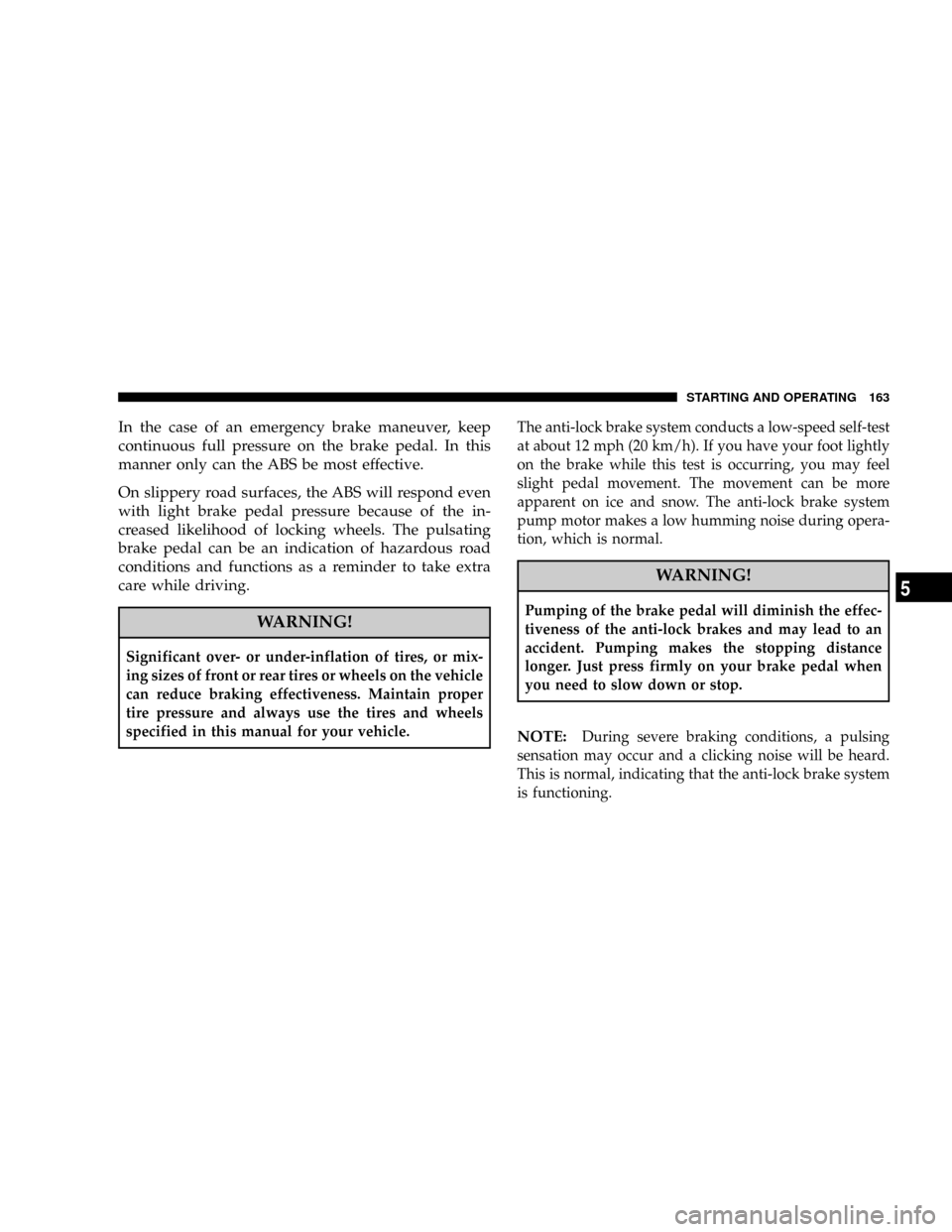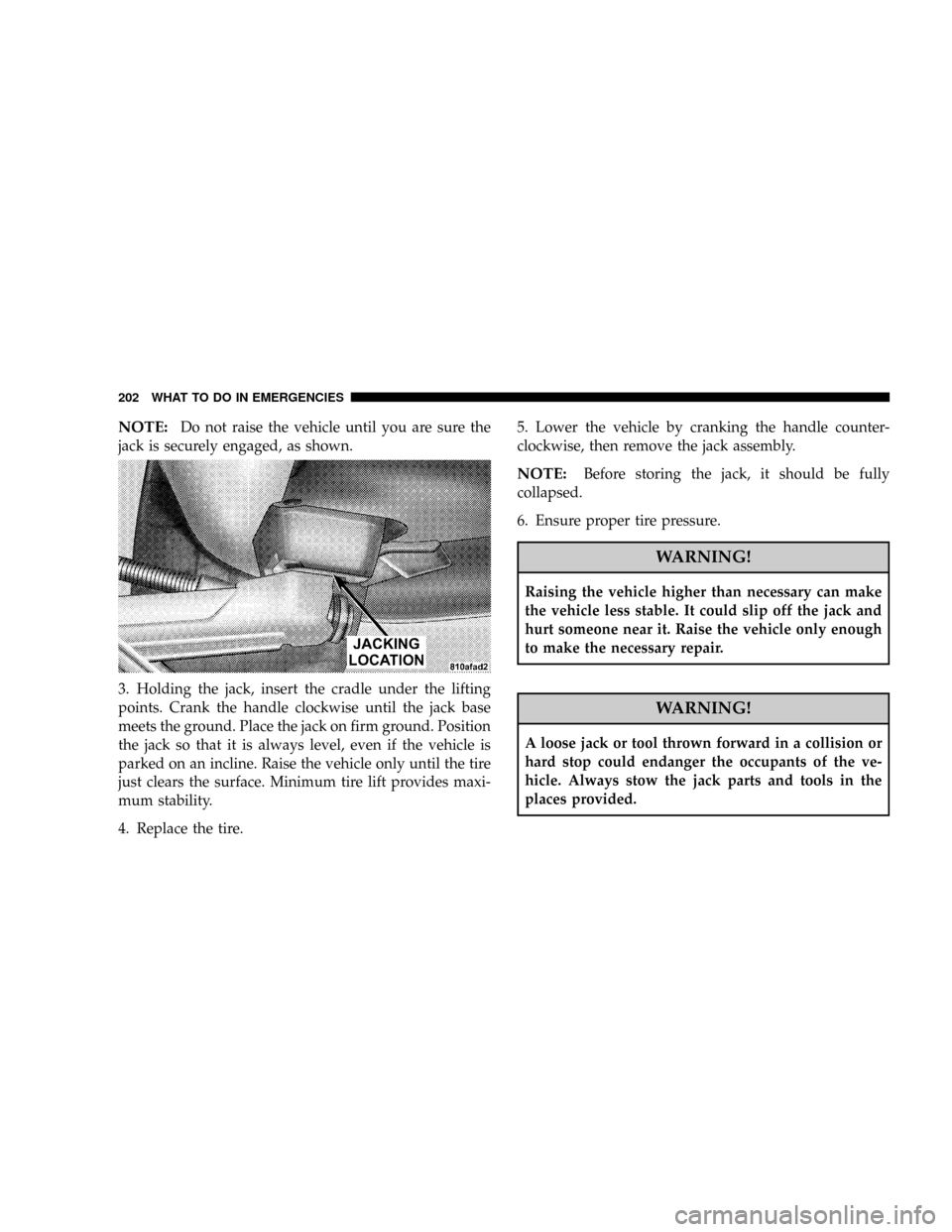lock CHRYSLER CROSSFIRE 2007 1.G Repair Manual
[x] Cancel search | Manufacturer: CHRYSLER, Model Year: 2007, Model line: CROSSFIRE, Model: CHRYSLER CROSSFIRE 2007 1.GPages: 299, PDF Size: 8.26 MB
Page 163 of 299

In the case of an emergency brake maneuver, keep
continuous full pressure on the brake pedal. In this
manner only can the ABS be most effective.
On slippery road surfaces, the ABS will respond even
with light brake pedal pressure because of the in-
creased likelihood of locking wheels. The pulsating
brake pedal can be an indication of hazardous road
conditions and functions as a reminder to take extra
care while driving.
WARNING!
Significant over- or under-inflation of tires, or mix-
ing sizes of front or rear tires or wheels on the vehicle
can reduce braking effectiveness. Maintain proper
tire pressure and always use the tires and wheels
specified in this manual for your vehicle.The anti-lock brake system conducts a low-speed self-test
at about 12 mph (20 km/h). If you have your foot lightly
on the brake while this test is occurring, you may feel
slight pedal movement. The movement can be more
apparent on ice and snow. The anti-lock brake system
pump motor makes a low humming noise during opera-
tion, which is normal.
WARNING!
Pumping of the brake pedal will diminish the effec-
tiveness of the anti-lock brakes and may lead to an
accident. Pumping makes the stopping distance
longer. Just press firmly on your brake pedal when
you need to slow down or stop.
NOTE:During severe braking conditions, a pulsing
sensation may occur and a clicking noise will be heard.
This is normal, indicating that the anti-lock brake system
is functioning.
STARTING AND OPERATING 163
5
Page 164 of 299

The ABS malfunction indicator light in the instrument
cluster comes on with the key in the ignition switch
turned to the ON/RUN position, and should go out with
the engine running. If the ABS light does not illuminate
briefly during this procedure, or remains on after the
engine is running, have the system checked by an autho-
rized dealer.When the ABS malfunction indicator light in the instru-
ment cluster comes on while the engine is running, it
indicates that the ABS has detected a malfunction and has
switched off. In this case, the brake system functions in
the usual manner, but without antilock assistance. With
the ABS malfunctioning, the BAS and ESP are also
switched off. Both malfunction indicator lights come on
with the engine running. If the charging voltage falls
below 10 volts, the malfunction indicator light comes on
and the ABS is switched off. When the voltage is above
this value again, the malfunction indicator light should
go out and the ABS is operational. If the malfunction
indicator light stays illuminated, have the system
checked at your authorized dealer as soon as possible.
164 STARTING AND OPERATING
Page 189 of 299

of unleaded gasoline having lower sulfur to determine if
the problem is fuel-related prior to returning your vehicle
to an authorized dealer for service.
CAUTION!
If the CHECK ENGINE Light is flashing, immediate
service is required. See the Onboard Diagnostic
System (OBDII) paragraph in the Maintaining Your
Vehicle section of this manual.
ADDING FUEL
Fuel Filler Cap (Gas Cap)
The gas cap is located under the fuel filler door, on the
passenger's side of the vehicle. To open the door, be sure it
is unlocked, then gently press the rear edge of the door
until a click can be heard, then release. The door rear edge
will spring open enough to grasp and pull it completely
open. If the central locking system does not release the fuel
filler door, see your authorized dealer for service. If the gas
cap is lost or damaged, be sure the replacement cap has
been designed for use with this vehicle.
CAUTION!
Damage to the fuel system or emission control sys-
tem could result from using an improper gas cap. A
poorly fitting cap could let impurities into the fuel
system. The CHECK ENGINE light will come on if
the gas cap is not properly secured.
NOTE:The fuel tank filler tube has a restricting door
about 2 inches (50 mm) down from the opening. If fuel is
poured from a portable container, the container should
have a flexible nozzle long enough to force open the
restricting door.
CAUTION!
To avoid fuel spillage and overfilling, do not ªtop
offº the fuel tank after filling.
STARTING AND OPERATING 189
5
Page 193 of 299

WHAT TO DO IN EMERGENCIES
CONTENTS
mHazard Warning Flasher.................194
mIf Your Engine Overheats................194
mTIREFIT Tire Repair And Jacking..........195
NTIREFIT............................195
NPreparations For Jacking................198
NJack Location And Instructions............200
mJump-Starting The Battery...............203
mDriving On Slippery Surfaces.............205NTraction............................205
mFreeing A Stuck Vehicle.................206
mTowing A Disabled Vehicle...............206
NTowing Eyes.........................208
NTow-Away Alarm.....................210
mConvertible Top Emergency Operation......211
NRelieving Hydraulic Pressure.............212
NOpening a Locked Decklid...............217
6
Page 194 of 299

HAZARD WARNING FLASHER
The flasher switch is located in the console. Push in
the flasher switch and all front and rear directional
signals will flash. Press the flasher switch a second
time to turn the flashers off.
Do not use this emergency warning system when the
vehicle is in motion. Use it when your vehicle is disabled
and is creating a safety hazard for other motorists.
If it is necessary to leave the vehicle to go for service, the
flasher system will continue to operate with the ignition
key removed and the vehicle locked.
NOTE:With extended use, the flasher may run down
your battery.
IF YOUR ENGINE OVERHEATS
During severe operating conditions and stop-and-go city
traffic, the coolant temperature may rise close to the red
area on the gauge.
The engine should not be operated with the coolant
temperature in the red area. Doing so may cause serious
damage which is not covered by the DaimlerChrysler
Limited Warranty.
In any of the following situations, you can reduce the
potential for overheating by taking the appropriate ac-
tion.
²On the highways ±Slow down and use the highest
gear possible.
²In city traffic ±While stopped, put the transmission in
Neutral, but do not increase engine idle speed.
²In city traffic ±While moving, shift into the highest
gear possible to reduce engine RPM.
194 WHAT TO DO IN EMERGENCIES
Page 198 of 299

16. If a tire pressure of 26 psi (180 kPa) is obtained, press
the air pump switch to 0, turn the ignition switch to the
OFF/LOCK position, and disconnect the TIREFIT sys-
tem.
17. Drive the vehicle for about 10 minutes to ensure
optimum distribution of the tire sealant within the tire.
18. Check the pressure in the tire. If the pressure is above
19 psi (130 kPa), inflate the tire to the pressure indicated
on the tire pressure label on the driver side latch pillar.
19. Have the tire inspected at the earliest opportunity at
an authorized dealer or tire service center.
NOTE:Do not exceed 50 mph (80 km/h) until the tire
has been inspected.
NOTE:If a pressure of at least 19 psi (130 kPa) cannot
be maintained in the tire, the tire is too badly damaged.
Do not attempt to drive the vehicle further, and call for
assistance.
NOTE:Do not operate the electric air pump for more
than eight minutes to avoid overheating. The air pump
may be used again once it has cooled down.
NOTE:Replace the TIREFIT sealant bottle once every
four years to assure optimum operation of the system.
NOTE:If TIREFIT is liquid, clean water and a damp
cloth will remove the material from the vehicle or tire and
wheel components. Once TIREFIT sealing material has
dried, it can easily be peeled off and properly discarded.
Preparations for Jacking
WARNING!
Getting under a jacked-up vehicle is dangerous. The
vehicle could slip off the jack and fall on you. You
could be crushed. Never get any part of your body
under a vehicle that is on a jack. Never start or run
the engine while the vehicle is on a jack. If you need
to get under a raised vehicle, take it to a service
facility where it can be raised on a lift.
198 WHAT TO DO IN EMERGENCIES
Page 200 of 299

²Block the wheel diagonally opposite the flat tire.
²Passengers must not remain in the vehicle when the
vehicle is jacked.
NOTE:The jack is designed exclusively for jacking up
the vehicle at the specified jack location points built
beneath either side of the vehicle.
Jack Location and Instructions
1. Remove the jack and jack handle from stowage be-
neath the cargo compartment carpet.
2. The lifting points for the jack are located beneath the
outer edge of the body side, directly behind the front
wheel housings, and in front of the rear wheel housings.
200 WHAT TO DO IN EMERGENCIES
Page 202 of 299

NOTE:Do not raise the vehicle until you are sure the
jack is securely engaged, as shown.
3. Holding the jack, insert the cradle under the lifting
points. Crank the handle clockwise until the jack base
meets the ground. Place the jack on firm ground. Position
the jack so that it is always level, even if the vehicle is
parked on an incline. Raise the vehicle only until the tire
just clears the surface. Minimum tire lift provides maxi-
mum stability.
4. Replace the tire.5. Lower the vehicle by cranking the handle counter-
clockwise, then remove the jack assembly.
NOTE:Before storing the jack, it should be fully
collapsed.
6. Ensure proper tire pressure.
WARNING!
Raising the vehicle higher than necessary can make
the vehicle less stable. It could slip off the jack and
hurt someone near it. Raise the vehicle only enough
to make the necessary repair.
WARNING!
A loose jack or tool thrown forward in a collision or
hard stop could endanger the occupants of the ve-
hicle. Always stow the jack parts and tools in the
places provided.
202 WHAT TO DO IN EMERGENCIES
Page 206 of 299

FREEING A STUCK VEHICLE
In order to free a stuck vehicle you must turn off the
Electronic Stability Program (ESP) before attempting to
ªrockº the vehicle.
If your vehicle becomes stuck in mud, sand or snow, it
can often be moved by a rocking motion. Turn your
steering wheel right and left to clear the area around the
front wheels. Then shift back and forth between Reverse
and Drive. Usually the least accelerator pedal pressure to
maintain the rocking motion without spinning the
wheels is most effective.
NOTE:ESP should be turned on again after freeing the
vehicle from a stuck condition.
CAUTION!
Racing the engine or spinning the wheels too fast
may lead to transmission/axle overheating and fail-
ure. It can also damage the tires. Do not spin the
wheels above 35 mph (55 km/h).
TOWING A DISABLED VEHICLE
We recommend that the vehicle be transported using flat
bed equipment. This method is preferable to other types
of towing.
CAUTION!
Important! If towing the vehicle, please note the
following: With the automatic central locking acti-
vated and the key in the ignition switch turned to the
ON/RUN position, the vehicle doors lock if the left
front wheel and the right rear wheel are turning at
vehicle speeds of approximately 9 mph (15 km/h) or
more. To prevent the vehicle door locks from locking,
deactivate the automatic central locking.
206 WHAT TO DO IN EMERGENCIES
Page 207 of 299

CAUTION!
If the vehicle is towed with the front wheels raised,
the engine must be shut off (key in the ignition
switch turned to the OFF/LOCK or ACC positions).
Otherwise, the ESP will immediately be engaged and
will apply the rear wheel brakes. Switch off the
tow-away alarm as well as the automatic central
locking system.
Towing restrictions for vehicles with automatic transmis-
sion: The vehicle may be towed with all wheels on the
ground and the transmission selector lever in the Neutral
position for distances up to 30 miles (48 km) and at a
speed not to exceed 30 mph (48 km/h). The key must be
turned to the ON/RUN position in the ignition. To be
certain to avoid a possibility of damage to the transmis-
sion, however, we recommend the drive shaft be discon-
nected at the rear axle drive flange for any towing
beyond a short tow to a nearby garage.Always comply with applicable state or local towing
ordinances.CAUTION!
²Do not attempt to tow this vehicle from the front
with sling-type towing equipment. Damage to the
front fascia will result.
²Always use wheel lift equipment when towing
from the front. The only other approved method of
towing is with a flatbed truck.
²Do not tow the vehicle from the rear. Damage to
the rear sheet metal and fascia will occur.
²Do not push or tow this vehicle with another
vehicle as damage to the bumper fascia and trans-
mission may result.
WHAT TO DO IN EMERGENCIES 207
6